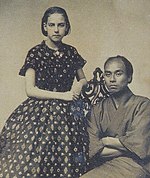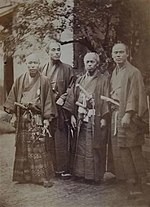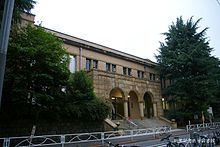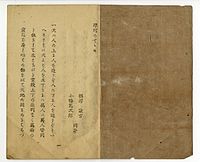|
阅读福泽谕吉 Fukuzawa Yukichi在百家争鸣的作品!!! |
福泽谕吉(1835年1月10日-1901年2月3日),日本近代重要启蒙思想家:出版说明1、教育家、东京学士会院首任院长、日本著名私立大学庆应义塾大学创立者、明治时代六大教育家之一,影响了明治维新运动,曾经作为1880年在日本设立的兴亚会的顾问。
虽然福泽谕吉本人并没有受到特定学说的影响而产生一贯的理论架构,福泽谕吉却是最早将经济学由英文世界引入日本的人之一。福泽谕吉是将复式记账法介绍给日本的第一人,将近代保险介绍给日本的也是福泽谕吉。为了表扬福泽对近代日本经济的贡献,大藏省理财局将福泽的头像印在1万日元的正面上。1984年,大藏省理财局曾计划将圣德太子的头像印在十万日元纸币上,野口英世的头像印在五万日元纸币上,福泽谕吉的头像印在一万日元纸币上,但十万元和五万元纸币最终没有发行,福泽谕吉也成为日本最高面额纸币上的人物。
生平
天保六年十二月十二日(1835年1月10日),福泽谕吉出生于摄津国大坂堂岛(今大阪府大阪市福岛区)。他出身于德川末期下级武士家庭:出版说明1,当时的丰前国中津藩(今属九州大分县中津市)藏屋敷的下等武士福泽百助的次子。由于他出生的当晚,作为儒学家的父亲刚刚获得《上谕条例》(记录清朝乾隆帝时期的法令的著作),因此给他取名为“谕吉”。谕吉的父亲既从事管理与大坂的商人的贷款业务,也是一位通晓儒学的学者。但是由于身份卑微,在等级制度森严的中津藩一直未能有所建树,终生不得志而溘然逝世。因此,谕吉在日后说“门阀等级制度是父亲的敌人”,他本人对封建制度也开始产生怀疑。
谕吉在1岁6个月的时候就失去了父亲,回到中津(现在的大分县)。他与他的兄弟或者当时的普通武士家子弟不同,并没有忠孝仁义的观念,也不敬神佛。他起初也非常厌倦读书,到了14-15岁的时候,由于周边环境的压力,他才开始学习。不久,他的能力就逐渐积累,渐渐地开始阅读各种汉文书籍。
安政元年(1854年),19岁的谕吉前往长崎学习兰学,成为他人生的转捩点。由于黑船来航后日本国内对火炮战术的需求高涨,而学习荷兰的火炮技术必须要有通晓荷兰语的人才,谕吉的兄长便建议谕吉学习荷兰语。此后谕吉拜访了长崎的火炮专家山本物次郎,在荷兰语翻译的指导下开始学习荷兰语。
安政二年(1855年),介绍谕吉认识山本的奥平壹岐与谕吉不和,便通知谕吉返回中津。但是,从离开中津那时便不打算再回去的谕吉却自行经过大坂前往江户(现东京)。他到大坂后,便去投靠与父亲同在中津藩藏屋敷工作的兄长。兄长劝阻他前往江户,并说服谕吉前往大坂学习兰学。于是谕吉便来到了绪方洪庵的适塾。这中间,因为患伤寒,曾暂时回到中津休养。
安政三年(1856年),福泽谕吉再次前往大坂求学。同年,由于兄长去世,他成为福泽家的户主。但是,他仍然没有放弃求学,变卖了父亲的藏书和部分家产后,还清了债务,虽然除了母亲以外的亲戚都表示反对,但是谕吉还是毅然前往大坂。由于他无力支付学费,便从奥平壹岐处借来便偷偷抄写的建设工程学的教科书《C.M.H.Pel,Handleiding tot de Kennis der Versterkingskunst,Hertogenbosch 》,并以翻译该书的名义作为绪方的食客而学习。1857年,谕吉成为适塾的塾长。他在塾中研读抄写荷兰语的原著,并根据书中的理论进行化学实验等。但是由于他害怕见到血,从来没有做过放血或者解剖手术。虽然适塾主要是教授医学,但是谕吉对荷兰语的学习超过了对医学的兴趣。
安政五年(1858年),福泽谕吉为了担任在江户的中津藩邸内设立的兰学塾的讲师,便和古川正雄(当时名为冈本周吉,后改名古川节藏)结伴前往江户。当时住在筑地铁炮洲的奥平家的中屋敷,在那里教授兰学。这个小规模的兰学塾后来成为了庆应义塾的前身,因此这一年便被定为庆应义塾大学的创立时间。
安政六年(1859年),谕吉前往横滨。当时,根据日美修好通商条约,横滨成为了外国人居留地。但是当地全用英语,学习了荷兰语的谕吉连招牌的文字都看不懂。从此他痛感学习英语的必要,便开始通过字典等自学英语。
同年冬,为了交换《日美修好通商条约》的批准文本,日本使团要乘坐美国的军舰Powhatan号赴美国,日本决定派遣咸临丸作为护卫舰。福泽谕吉作为咸临丸的军官木村摄津守的助手,在1860年前往美国。当时咸临丸的指挥官是胜海舟。之后,福泽也以在首次看到蒸汽船仅仅7年后就乘坐完全由日本人操纵的军舰横渡太平洋而感到自豪。他目击当时日本在列强环伺欺凌下,国家独立受到严重威胁,福泽以谋求国家独立富强为己任:出版说明1。
他早岁游历欧美,受近代科学和西方自由民主思想影响很深,回国以后,他极力介绍西方国家状况,传播自由平等之说,以倡导民权,促进“文明开化”,并鼓励日本人学习科学,兴办企业,发扬独立自主精神,以争取日本民族独立:出版说明1。虽然福泽已经在书上了解了很多美国的事物,但是还是受到了文化差异的震撼。例如他在书中写道,在日本,几乎没有人不知道德川家康子孙的近况,但是美国人几乎没有人了解乔治·华盛顿的后代们的生活。(事实上,华盛顿并没有留下后裔) 福泽还和同行的翻译中滨万次郎一起购买了韦伯字典的盗版书带回国内,成为日后研究的帮助。
回国后,他仍然在铁炮洲教授课程。但是此时他决定放弃荷兰语,专教英语,把兰学塾改变成英学塾。同时也受雇于幕府,从事政府公文的翻译。据说当时他对于不能理解的英文部分,还需要参考荷兰语的译本进行翻译。回国的当年,福泽还将在美国购买的汉语和英文对译本词汇集《华英通语》加入日语译文,作为《增订华英通语》出版。这是福泽谕吉最早出版的书籍。在书中,福泽将表示V的发音的假名“ウ”上面加上浊音符号变成“ヴ”,这成为后来日本通行的标注方法。
文久二年(1862年)冬天,日本派遣以竹内下野守为正使的使节团出使欧洲各国,福泽谕吉也随之同行。当时也用幕府发给的津贴费买了许多英文书籍带回日本。他在欧洲对于土地买卖等制度也感受到了文化的差异,并对于许多在书本上无法看到的事物进行调查。例如欧洲人习以为常但日本人前所未闻的医院、银行、邮政法、征兵令、选举、议会等。
通过这几次参加海外使团的经历,福泽痛感在日本普及西学的重要。回国后,他写作了《西洋事情》等书,开始了对西学的启蒙运动。当时,他曾作为官员提倡幕府机构的改革,但在1868年(庆应4年)后,便将兰学塾改名为“庆应义塾”,专心从事教育活动。
晚年
在明治维新后,福泽谕吉继续大力提倡普及西学。并针对日益高涨的国会设立运动,提出创立英国流的不成文宪法的论调。他在明治十四年(1881年)的明治十四年政变后与政府要人绝交,在1882年创办日报《时事新报(日语)》,遵循不偏不倚的立场,引导社会舆论。
逝世
明治三十一年(1898年)福泽谕吉因为脑出血而病倒,之后虽然一度康复,但福泽谕吉还是在明治三十四年十二月十五日(1901年2月3日)因为脑中风而溘然长逝,享寿六十六岁。
身后
戒名“大观院独立自尊居士”。在葬礼上,遗属遵从福泽的遗志,婉拒了各方的献花,但是唯独默然收下了福泽谕吉的盟友大隈重信送来的丧礼。
思想
福泽谕吉主要的思想特征是反对封建社会的身份制度。他激烈地抨击封建时代的专制压抑。福泽在其著作《劝学篇》第一篇开篇第一句即是“天在人之上不造人,天在人之下不造人”可见其对于封建专制的抨击和对自由平等的肯定。更在《劝学篇》后续篇章中提倡男女平等,婚姻自由等近代化思想。此外,他也吸收了西方的社会契约论,提出要使国民和政府的力量相对均衡。这种均衡说体现了福泽独特的政治理念,反映出他并非完全照搬西方的政治学说。此外,福泽在其著作《劝学篇》中强调“一人之自由独立关系到国家之自由独立”。而要达到个人的自由独立,就必须要具备数学、地理、物理、历史等等现代科学知识。福泽的代表性语言就是“独立自尊”,这也成为了他死后的戒名。福泽毫无疑问是明治维新时代的最具影响力的思想家之一,其著名著作《劝学篇》17篇、《福翁自传》、《脱亚论》。尤其是《劝学篇》十七篇,在当时的日本几乎人手一本。
劝学篇原文应为“虽然有句话说天在人之上不造人,天在人之下不造人、但是实际上并无平等之事,有富者亦有贫者,有智者亦有愚者。然其差别如何而来,此即是否具学问之别,各位,一起研究学问吧。”此为劝学原旨,与本篇中引申义有些微出入。
经济思想
福泽谕吉虽是最早将经济学由英文世界引入亚洲的人之一(如试将competition译为竞争),他本人却没有受到特定学说的影响而产生一贯的理论架构。在早期所著的《西洋事情》外编的一部分,福泽直接翻译了美国人Chambers所写Educational Course之中的政治经济学部分,故出现了所谓经济社会由竞争所决定的市场论(“经济之定则”);在《劝学篇》中也多次提及亚当斯密的自由市场经济论。而在稍后期的《文明论概略》里,福泽进一步反对“伪君子”的反竞争论,而强调每个人要有秉著“数理”、“实学”的精神,产生智慧、俭约与正直之心;国家要从“半开”到文明,经济发展之诀在于正直地面对营利赚钱的期望。由此可知,后期的福泽在客观的市场竞争外福泽更强调了人作为行为主体的重要性。福泽指谪,开国之初的日本多进口工业财而出口原物料,长期而言将使整体丧失所谓“制产之利”,主张贸易保护的同时,也呼吁稻农改种桑树,由自给发展至输出,以增强日本纺织业的竞争力。其所著《通货论》,在因“不换纸币”大行而引致通货膨胀的同时,顾到政府货币政策的困难而支持政府的纸币流通政策;而在松方财政后又在报纸上发表续篇,拥护通货管制论,强调货币与贸易市场的连动关系。至于在地租改正的问题上,福泽站在反地主的立场,反对地租(土地税)轻减政策: 由于佃农的租金由市场供需决定,故地主作为不生产阶级所上缴的土地税若减少,则只会满足其贪婪兼并的意愿。
脱亚论
福泽谕吉终其一生都致力于在日本弘扬西方文明,介绍西方政治制度以及相应的价值观。他在《时事新报》发表了著名的短文《脱亚论》,积极地提倡在明治维新后的日本应该放弃中华思想和儒教的精神,而吸收学习西洋文明。基于优胜劣汰的思想,他认定东方文明必定失败,因此他呼吁与东亚邻国绝交,避免日本被西方视为与邻国同样的“野蛮”之地。他对当时的东亚其他国家采取蔑视的态度,比如将中日甲午战争描述为一场“文野(文明与野蛮)之战”;认为朝鲜王朝、清朝是“恶友”。故而《脱亚论》又被认为是日本思想界对亚洲的“绝交书”,受到当时欧洲帝国主义流行的影响、主张全盘西化的观点,甚至被比作军国主义的始祖,因为西方的侵略思想推进了日本开始跟随着欧美列强的脚步,也走上对外扩张的道路。
但福泽谕吉对于西洋文明并非没有取舍。可以说在其自由主义的表象之下,始终贯彻不移的是他的民族主义思想。此后,也有人批评福泽是一位肯定侵略行为的种族歧视主义者。但是,根据平山洋的《福泽谕吉的真实》(文春新书)的文字,其实这应该归因于《福泽谕吉传》的作者、《时事新报》的主笔、《福泽全集》的主编石河干明。
根据平山的论点,虽然福泽批评了中国与朝鲜的政府,但是并不是贬低其民族本身。至于将清朝的士兵称为“猪猡”等种族歧视的说法,其实是石河将自己的观点伪造成福泽的说法写入全集的。但是,对于这种观点,仍有不少人表示质疑。但根据《脱亚论》,事实上当时福泽认为日本、中国之间如同近邻。而日本已经将旧的茅草房改建成石房,但中国仍然是茅草房。所以福泽认为应该想方法令中国也改建为石房,不然代表中国的茅草房着火一样会影响到改建成石房的日本。为了代表日本的房子的安全,日本应该不惜强占还是草房的中国、朝鲜,帮助其改建成石房。而且事实上,福泽甚至还通过出资购买武器来资助过当时朝鲜的政变。
言论
影响
福泽毕生从事教育和著述工作,大力发展日本资本主义和推动民主运动:出版说明1。由于福泽生前居住在庆应义塾的校区内,因此现在在他去世时所在的庆应义塾大学三田校区内设有石碑。戒名是“大观院独立自尊居士”,墓地在麻布山善福寺。每年2月3日(福泽谕吉的忌日)被称为雪池忌,校长会带领众多师生前往扫墓。庆应义塾大学在传统上将创始人福泽谕吉称呼为“福泽先生”,一般师生间的称呼则为“〇〇君”。
福泽由于是1万日元的正面人物而在日本家喻户晓。有时候人们也将1万日元直接叫做“福泽谕吉”、“谕吉”或者“谕吉券”。也因此,有人在数1万元纸币的张数时,会以1人、2人的人数来计数。1984年,大藏省理财局曾计划将圣德太子的头像印在十万日元纸币上,野口英世的头像印在五万日元纸币上,福泽谕吉的头像印在一万日元纸币上,但十万元和五万元纸币最终没有发行,福泽谕吉也成为日本最高面额纸币上的人物,野口英世的头像则于2004年被印在一千日元纸币上。
福泽也是将会计学的基础“复式记账法”介绍给日本的第一人。“借方”、“贷方”的用语也是福泽首先翻译的。
首先将近代保险制度介绍给日本的也是福泽谕吉。他在《西洋旅案内》(中译:西洋旅游介绍)中介绍了人寿保险、火灾保险和意外伤害保险等三种保险制度。
主要著作
福泽著译很多,共有六十余种,《文明论概略》和《劝学篇》是他两部代表性著作,当时畅销全日本,在日本知识界有很大影响:出版说明1。
- 《劝学篇》
- 《文明论概略》
- 《西洋事情》
- 《日々の教え》
- 《通俗民权论》
- 《通俗国权论》
- 《民情一新》
- 《时事小言》
- 《福翁自传》
- 《福翁百话》
- 《瘠我慢之说》
- 《丁丑公论》
中文译本
- 《劝学篇》 群力译,商务印书馆,首次出版年月:1958年,印刷年月:1996年,ISBN 7100020530
- 《文明论概略(汉译世界学术名著丛书)》 北京编译社译,商务印书馆,1982年6月北京第3次印刷;1995年3月北京第6次印刷,ISBN 7100013038
- 《福泽谕吉与文明论概略/人之初名著导读丛书》 鲍成学 刘在平 编著,2001年,中国少年儿童出版社,ISBN 7500755996
- 《福泽谕吉自传》 马斌译,商务印书馆,1980年,ISBN 7100014220
- 《福翁百话:福泽谕吉随笔集》 唐云译;张新华译;蔡院森译;侯侠译,三联书店上海分店,1993年,ISBN 7542605860
- 《福泽谕吉教育论著选/外国教育名著丛书》 王桂主译,人民教育出版社,2005年,ISBN 7107174630
- 《劝学》,徐雪蓉译,台湾台北市:五南文化出版,二零一三年,国际书号ISBN 9789571172545。
登场作品
- 影视剧
- 风暴花开(1940年、东宝、演:大河内传次郎)
- 福泽谕吉的少年时代(1958年、NHK、演:森勇)
- 激流 福泽桃介传(1959年、MBS、演:柳永二郎)
- 明日的钟声(1961年、NHK、演:木浪茂 → 前田昌明)
- 巨人 大隈重信(1963年、大映、演:船越英二)
- 榎本武扬(1964年、NHK、演:久米明)
- 天皇的世纪(1971年、ABC、演:大出俊)
- 胜海舟(1974年、NHK大河剧、演:青山良彦)
- 明治群像:海上火轮(1976年、NHK、演:高桥昌也)
- 花神(1977年、NHK大河剧、演:入川保则)
- 告别适塾(1981年、MBS、演:篠田三郎)
- 燃烧青春热血:福泽谕吉与明治群像(1984年、TX、演:泷泽修)
- 幕末青春涂鸦:福泽谕吉(195年、TBS、演:中村勘九郎)
- 春之波涛(1985年、NHK大河剧、演:小林桂树)
- 五棱郭(1988年、NTV、演:中村雅俊)
- 胜海舟(1990年、NTV、演:石原良纯)
- 福泽谕吉(1991年、东映、演:柴田恭兵)
- EAST MEETS WEST(1995年、松竹、演:桥爪淳)
- 走向共和(2003年、CCTV、演:小林龙夫)
- 破天荒力(2008年、Sazanami、演:中村繁之)
- 缔创学校(2010年、GO CINEMA、演:宅麻伸)
- 阿浅(2015年、NHK、演:武田铁矢)
参见
注释
参考文献
- 《福泽谕吉与日本近代化》 [日]丸山真男著,区建英译,学林出版社,1992年,ISBN 7805107534
- 《让福泽谕吉自己谈自己吧!》 [日]井田进也著,中华读书报,2005年
Fukuzawa Yukichi (福澤 諭吉, January 10, 1835 – February 3, 1901) was a Japanese author, writer, teacher, translator, entrepreneur, journalist, and leader who founded Keio University, Jiji-Shinpō (a newspaper) and the Institute for Study of Infectious Diseases.
Fukuzawa was an early Japanese advocate for reform. Fukuzawa's ideas about the organization of government and the structure of social institutions made a lasting impression on a rapidly changing Japan during the Meiji period.
Fukuzawa is regarded as one of the founders of modern Japan.
Early life
Fukuzawa Yukichi was born into an impoverished low-ranking samurai family of the Okudaira Clan of Nakatsu (now Ōita, Kyushu) in 1835. His family lived in Osaka, the main trading center for Japan at the time. His family was poor following the early death of his father, who was also a Confucian scholar. At the age of 5 he started Han learning, and by the time he turned 14 had studied major writings such as the Analects, Tao Te Ching, Zuo Zhuan and Zhuangzi. Fukuzawa was greatly influenced by his lifelong teacher, Shōzan Shiraishi, who was a scholar of Confucianism and Han learning. When he turned 19 in 1854, shortly after Commodore Matthew C. Perry's arrival in Japan, Fukuzawa's brother (the family patriarch) asked Yukichi to travel to Nagasaki, where the Dutch colony at Dejima was located, in order to enter a school of Dutch studies (rangaku). He instructed Yukichi to learn Dutch so that he might study European cannon designs and gunnery.
Fukuzawa spent the beginning of his walk of life just trying to survive the backbreaking yet dull life of a lower-level samurai in Japan during the Tokugawa period. Although Fukuzawa did travel to Nagasaki, his stay was brief as he quickly began to outshine his host in Nagasaki, Okudaira Iki. Okudaira planned to get rid of Fukuzawa by writing a letter saying that Fukuzawa's mother was ill. Seeing through the fake letter Fukuzawa planned to travel to Edo and continue his studies there because he knew he would not be able to in his home domain, Nakatsu, but upon his return to Osaka, his brother persuaded him to stay and enroll at the Tekijuku school run by physician and rangaku scholar Ogata Kōan. Fukuzawa studied at Tekijuku for three years and became fully proficient in the Dutch language. In 1858, he was appointed official Dutch teacher of his family's domain, Nakatsu, and was sent to Edo to teach the family's vassals there.
The following year, Japan opened up three of its ports to American and European ships, and Fukuzawa, intrigued with Western civilization, traveled to Kanagawa to see them. When he arrived, he discovered that virtually all of the European merchants there were speaking English rather than Dutch. He then began to study English, but at that time, English-Japanese interpreters were rare and dictionaries nonexistent, so his studies were slow.
In 1859, the Tokugawa shogunate sent the first diplomatic mission to the United States. Fukuzawa volunteered his services to Admiral Kimura Yoshitake. Kimura's ship, the Kanrin Maru, arrived in San Francisco, California, in 1860. The delegation stayed in the city for a month, during which time Fukuzawa had himself photographed with an American girl, and also found a Webster's Dictionary, from which he began serious study of the English language.
Political movements
Upon his return in 1860, Fukuzawa became an official translator for the Tokugawa bakufu. Shortly thereafter he brought out his first publication, an English-Japanese dictionary which he called "Kaei Tsūgo" (translated from a Chinese-English dictionary) which was a beginning for his series of later books. In 1862, he visited Europe as one of the two English translators in bakufu's 40-man embassy, the First Japanese Embassy to Europe. During its year in Europe, the Embassy conducted negotiations with France, England, the Netherlands, Prussia, and finally Russia. In Russia, the embassy unsuccessfully negotiated for the southern end of Sakhalin (in Japanese Karafuto).
The information collected during these travels resulted in his famous work Seiyō Jijō (西洋事情, "Things western"), which he published in ten volumes in 1867, 1868 and 1870. The books describe western culture and institutions in simple, easy to understand terms, and they became immediate best-sellers. Fukuzawa was soon regarded as the foremost expert on western civilization, leading him to conclude that his mission in life was to educate his countrymen in new ways of thinking in order to enable Japan to resist European imperialism.
In 1868 he changed the name of the school he had established to teach Dutch to Keio Gijuku, and from then on devoted all his time to education. He had even added Public speaking to the educational system's curriculum. While Keiō's initial identity was that of a private school of Western studies (Keio-gijuku), it expanded and established its first university faculty in 1890. Under the name Keio-Gijuku University, it became a leader in Japanese higher education.
Fukuzawa was also a strong advocate for women’s rights. He often spoke up in favor of equality between husbands and wives, the education of girls as well as boys, and the equal love of daughters and sons. At the same time, he called attention to harmful practices such as women’s inability to own property in their own name and the familial distress that took place when married men took mistresses. However, even Fukuzawa was not willing to propose completely equal rights for men and women; only for husbands and wives. He also stated in his 1899 book New Greater Learning for Women that a good marriage was always the best outcome for a young woman, and according to some of Fukuzawa's personal letters, he discouraged his friends from sending their daughters on to higher education so that they would not become less desirable marriage candidates. While some of Yukichi’s other proposed reforms, such as education reforms, found an eager audience, his ideas about women received a less enthusiastic reception. Many[who?] in Japan were incredibly reluctant to challenge the traditional gender roles, in spite of numerous individuals speaking up in favor of greater gender equality.[citation needed]
After suffering a stroke on January 25, 1901, Fukuzawa Yukichi died on February 3. He was buried at Zenpuku-ji, in the Azabu area of Tokyo. Alumni of Keio-Gijuku University hold a ceremony there every year on February 3.
Works
Fukuzawa's writings may have been the foremost of the Edo period and Meiji period. They played a large role in the introduction of Western culture into Japan.
English-Japanese Dictionary
In 1860, he published English-Japanese Dictionary ("Zōtei Kaei Tsūgo"). It was his first publication. He bought English-Chinese Dictionary ("Kaei Tsūgo") in San Francisco in 1860. He translated it to Japanese and he added the Japanese translations to the original textbook. In his book, he invented the new Japanese characters VU (ヴ) to represent the pronunciation of VU, and VA (ヷ) to represent the pronunciation of VA. For example, the name Beethoven is written as ベートーヴェン in Japanese now.
All the Countries of the World, for Children Written in Verse
His famous textbook Sekai Kunizukushi ("All the Countries of the World, for Children Written in Verse", 1869) became a best seller and was used as an official school textbook. His inspiration for writing the books came when he tried to teach world geography to his sons. At the time there were no textbooks on the subject, so he decided to write one himself. He started by buying a few Japanese geography books for children, named Miyakoji ("City roads") and Edo hōgaku ("Tokyo maps"), and practiced reading them aloud. He then wrote Sekai Kunizukushi in six volumes in the same lyrical style. The first volume covered Asian countries, the second volume detailed African countries, European countries were discussed in the third, South American countries in the fourth, and North American countries and Australia in the fifth. Finally, the sixth volume was an appendix that gave an introduction to world geography.
An Encouragement of Learning
Between 1872 and 1876, he published 17 volumes of Gakumon no Susume ( 学問のすすめ, "An Encouragement of Learning" or more idiomatically "On Studying"). In these texts, Fukuzawa outlines the importance of understanding the principle of equality of opportunity and that study was the key to greatness. He was an avid supporter of education and believed in a firm mental foundation through education and studiousness. In the volumes of Gakumon no Susume, influenced by Elements of Moral Science (1835, 1856 ed.) by Brown University President Francis Wayland, Fukuzawa advocated his most lasting principle, "national independence through personal independence." Through personal independence, an individual does not have to depend on the strength of another. With such a self-determining social morality, Fukuzawa hoped to instill a sense of personal strength among the people of Japan, and through that personal strength, build a nation to rival all others. His understanding was that western society had become powerful relative to other countries at the time because western countries fostered education, individualism (independence), competition and exchange of ideas.
An Outline of a Theory of Civilization
Fukuzawa published many influential essays and critical works. A particularly prominent example is Bunmeiron no Gairyaku ( 文明論之概略, "An Outline of a Theory of Civilization") published in 1875, in which he details his own theory of civilization. It was influenced by Histoire de la civilisation en Europe (1828; Eng. trans in 1846) by François Guizot and History of Civilization in England (1872–1873, 2nd London ed.) by Henry Thomas Buckle. According to Fukuzawa, civilization is relative to time and circumstance, as well in comparison. For example, at the time China was relatively civilized in comparison to some African colonies, and European nations were the most civilized of all.
Colleagues in the Meirokusha intellectual society shared many of Fukuzawa's views, which he published in his contributions to Meiroku Zasshi (Meiji Six Magazine), a scholarly journal he helped publish. In his books and journals, he often wrote about the word "civilization" and what it meant. He advocated a move toward "civilization", by which he meant material and spiritual well-being, which elevated human life to a "higher plane". Because material and spiritual well-being corresponded to knowledge and "virtue", to "move toward civilization" was to advance and pursue knowledge and virtue themselves. He contended that people could find the answer to their life or their present situation from "civilization." Furthermore, the difference between the weak and the powerful and large and small was just a matter of difference between their knowledge and education.
He argued that Japan should not import guns and materials. Instead it should support the acquisition of knowledge, which would eventually take care of the material necessities. He talked of the Japanese concept of being practical or pragmatic (実学, jitsugaku) and the building of things that are basic and useful to other people. In short, to Fukuzawa, "civilization" essentially meant the furthering of knowledge and education.
Criticism
Fukuzawa was later criticized[citation needed] as a supporter of Japanese imperialism because of an essay "Datsu-A Ron" ("Escape from Asia") published in 1885 and posthumously attributed to him, as well as for his support of the First Sino-Japanese War (1894–1895). Yet, "Datsu-A Ron" was actually a response to a failed attempt by Koreans to organize an effective reform faction.[citation needed] The essay was published as a withdrawal of his support.
According to Fukuzawa Yukichi no Shinjitsu ("The Truth of Fukuzawa Yukichi", 2004) by Yō Hirayama, this view is a misunderstanding due to the influence of Mikiaki Ishikawa, who was the author of a biography of Fukuzawa (1932) and the editor of his Complete Works (1925–1926 and 1933–1934). According to Hirayama, Ishikawa inserted anonymous editorials into the Complete Works, and inserted historically inaccurate material into his biography.
Legacy
Fukuzawa's most important contribution to the reformation effort, though, came in the form of a newspaper called Jiji Shinpō (時事新報, "Current Events"), which he started in 1882, after being prompted by Inoue Kaoru, Ōkuma Shigenobu, and Itō Hirobumi to establish a strong influence among the people, and in particular to transmit to the public the government's views on the projected national assembly, and as reforms began, Fukuzawa, whose fame was already unquestionable, began production of Jiji Shinpo, which received wide circulation, encouraging the people to enlighten themselves and to adopt a moderate political attitude towards the change that was being engineered within the social and political structures of Japan. He translated many books and journals into Japanese on a wide variety of subjects, including chemistry, the arts, military and society, and published many books (in multiple volumes) and journals himself describing Western society, his own philosophy and change, etc.
Fukuzawa was one of the most influential people ever that helped Japan modernize into the country it is today. He never accepted any high position and remained a normal Japanese citizen for his whole life. By the time of his death, he was revered as one of the founders of modern Japan. All of his work was written and was released at a critical juncture in the Japanese society and uncertainty for the Japanese people about their future after the signing of the Unequal treaties, their realization in the weakness of the Japanese government at the time (Tokugawa Shogunate) and its inability to repel the American and European influence. It should also be noted that there were bands of samurai that forcefully opposed the Americans and Europeans and their friends through murder and destruction. Fukuzawa was in danger of his life as a samurai group killed one of his colleagues for advocating policies like those of Fukuzawa. Fukuzawa wrote at a time when the Japanese people were undecided on whether they should be bitter about the American and European forced treaties and imperialism, or to understand the West and move forward. Fukuzawa greatly aided the ultimate success of the pro-modernization forces.
Fukuzawa appears on the current 10,000-yen banknote and has been compared to Benjamin Franklin in the United States. Franklin appears on the similarly-valued $100 bill. Although all other figures appearing on Japanese banknotes changed when the recent redesign was released, Fukuzawa remained on the 10,000-yen note.
Yukichi Fukuzawa's former residence in the city of Nakatsu in Ōita Prefecture is a Nationally Designated Cultural Asset. The house and the Yukichi Fukuzawa Memorial Hall are the major tourist attractions of this city.
Yukichi Fukuzawa was a firm believer that Western education surpassed Japan's. However, he did not like the idea of parliamentary debates. As early as 1860, Yukichi Fukuzawa traveled to Europe and the United States. He believed that the problem in Japan was the undervalued mathematics and science.[citation needed] Also, these suffered from a "lack of the idea of independence". The Japanese conservatives were not happy about Fukuzawa's view of Western education. Since he was a family friend of conservatives, he took their stand to heart. Fukuzawa later came to state that he went a little too far.
One word sums up his entire theme and that is "independence". Yukichi Fukuzawa believed that national independence was the framework to society in the West. However, to achieve this independence, as well as personal independence, Fukuzawa advocated Western learning. He believed that public virtue would increase as people became more educated.
Bibliography
Original Japanese books
- English-Japanese dictionary (増訂華英通語 Zōtei Kaei Tsūgo, 1860)
- Things western (西洋事情 Seiyō Jijō, 1866, 1868 and 1870)
- Rifle instruction book (雷銃操法 Raijyū Sōhō, 1867)
- Guide to travel in the western world (西洋旅案内 Seiyō Tabiannai, 1867)
- Our eleven treaty countries (条約十一国記 Jyōyaku Jyūichi-kokki, 1867)
- Western ways of living: food, clothes, housing (西洋衣食住 Seiyō Isyokujyū, 1867)
- Handbook for soldiers (兵士懐中便覧 Heishi Kaicyū Binran, 1868)
- Illustrated book of physical sciences (訓蒙窮理図解 Kinmō Kyūri Zukai, 1868)
- Outline of the western art of war (洋兵明鑑 Yōhei Meikan, 1869)
- Pocket almanac of the world (掌中万国一覧 Shōcyū Bankoku-Ichiran, 1869)
- English parliament (英国議事院談 Eikoku Gijiindan, 1869)
- Sino-British diplomatic relations (清英交際始末 Shin-ei Kosai-shimatsu, 1869)
- All the countries of the world, for children written in verse (世界国尽 Sekai Kunizukushi, 1869)
- Daily lesson for children (ひびのおしえ Hibi no Oshie, 1871) - These books were written for Fukuzawa's first son Ichitarō and second son Sutejirō.
- Book of reading and penmanship for children (啓蒙手習の文 Keimō Tenarai-no-Fumi, 1871)
- Encouragement of learning (学問のすゝめ Gakumon no Susume, 1872–1876)
- Junior book of ethics with many tales from western lands (童蒙教草 Dōmō Oshie-Gusa, 1872)
- Deformed girl (かたわ娘 Katawa Musume, 1872)
- Explanation of the new calendar (改暦弁 Kaireki-Ben, 1873)
- Bookkeeping (帳合之法 Chōai-no-Hō, 1873)
- Maps of Japan for children (日本地図草紙 Nihon Chizu Sōshi, 1873)
- Elementary reader for children (文字之教 Moji-no-Oshie, 1873)
- How to hold a conference (会議弁 Kaigi-Ben, 1874)
- An Outline of a Theory of Civilization (文明論之概略 Bunmeiron no Gairyaku, 1875)
- Independence of the scholar's mind (学者安心論 Gakusya Anshinron, 1876)
- On decentralization of power, advocating less centralized government in Japan (分権論 Bunkenron, 1877)
- Popular economics (民間経済録 Minkan Keizairoku, 1877)
- Collected essays of Fukuzawa (福澤文集 Fukuzawa Bunsyū, 1878)
- On currency (通貨論 Tsūkaron, 1878)
- Popular discourse on people's rights (通俗民権論 Tsūzoku Minkenron, 1878)
- Popular discourse on national rights (通俗国権論 Tsūzoku Kokkenron, 1878)
- Transition of people's way of thinking (民情一新 Minjyō Isshin, 1879)
- On national diet (国会論 Kokkairon, 1879)
- Commentary on the current problems (時事小言 Jiji Shōgen, 1881)
- On general trends of the times (時事大勢論 Jiji Taiseiron, 1882)
- On the imperial household (帝室論 Teishitsuron, 1882)
- On armament (兵論 Heiron, 1882)
- On moral training (徳育如何 Tokuiku-Ikan, 1882)
- On the independence of learning (学問之独立 Gakumon-no Dokuritsu, 1883)
- On the national conscription (全国徴兵論 Zenkoku Cyōheiron, 1884)
- Popular discourse on foreign diplomacy (通俗外交論 Tsūzoku Gaikōron, 1884)
- On Japanese womanhood (日本婦人論 Nihon Fujinron, 1885)
- On men's moral life (士人処世論 Shijin Syoseiron, 1885)
- On moral conduct (品行論 Hinkōron, 1885)
- On association of men and women (男女交際論 Nannyo Kosairon, 1886)
- On Japanese manhood (日本男子論 Nihon Nanshiron, 1888)
- On reverence for the Emperor (尊王論 Sonnōron, 1888)
- Future of the Diet; Origin of the difficulty in the Diet; Word on the public security; On land tax (国会の前途 Kokkai-no Zento; Kokkai Nankyoku-no Yurai; Chian-Syōgen; Chisoron, 1892)
- On business (実業論 Jitsugyōron, 1893)
- One hundred discourses of Fukuzawa (福翁百話 Fukuō Hyakuwa, 1897)
- Foreword to the collected works of Fukuzawa (福澤全集緒言 Fukuzawa Zensyū Cyogen, 1897)
- Fukuzawa sensei's talk on the worldly life (福澤先生浮世談 Fukuzawa Sensei Ukiyodan, 1898)
- Discourses of study for success (修業立志編 Syūgyō Rittishihen, 1898)
- Autobiography of Fukuzawa Yukichi (福翁自伝 Fukuō Jiden, 1899)
- Reproof of "the essential learning for women"; New essential learning for women (女大学評論 Onnadaigaku Hyōron; 新女大学 Shin-Onnadaigaku, 1899)
- More discourses of Fukuzawa (福翁百余話 Fukuō Hyakuyowa, 1901)
- Commentary on the national problems of 1877; Spirit of manly defiance (明治十年丁丑公論 Meiji Jyūnen Teicyū Kōron; 瘠我慢の説 Yasegaman-no Setsu, 1901)
English translations
- The Autobiography of Yukichi Fukuzawa, Revised translation by Eiichi Kiyooka, with a foreword by Carmen Blacker, NY: Columbia University Press, 1980, ISBN 978-0-231-08373-7
- The Autobiography of Yukichi Fukuzawa, Revised translation by Eiichi Kiyooka, with a foreword by Albert M. Craig, NY: Columbia University Press, 2007, ISBN 978-0-231-13987-8
- The Thought of Fukuzawa series, (Paperback) Keio University Press
- vol.1 福澤諭吉 (2008), An Outline of a Theory of Civilization, Translation by David A. Dilworth, G. Cameron Hurst, III, ISBN 978-4-7664-1560-5
- vol.2 福澤諭吉 (2012), An Encouragement of Learning, Translation by David A. Dilworth, ISBN 978-4-7664-1684-8
- vol.3 福澤諭吉 (2017), Fukuzawa Yukichi on Women and the Family, Edited and with New and Revised Translations by Helen Ballhatchet, ISBN 978-4-7664-2414-0
- Vol.4 The Autobiography of Fukuzawa Yukichi. Revised translation and with an introduction by Helen Ballhatchet.
See also
Notes
- ^ a b Nishikawa (1993)
- ^ a b c d e f Hopper, Helen M. (2005). Fukuzawa Yukichi : from samurai to capitalist. New York: Pearson/Longman. ISBN 978-0321078025. OCLC 54694712.
- ^ Dilworth (2012)
- ^ Dilworth & Hurst (2008)
- ^ Adas, Stearns & Schwartz (1993, p. 36).
- ^ Adas, Stearns & Schwartz (1993, p. 37).
References
- Adas, Michael; Stearns, Peter; Schwartz, Stuart (1993), Turbulent Passage: A Global History of the Twentieth Century, Longman Publishing Group, ISBN 978-0-06-501039-8
- Nishikawa, Shunsaku (西川俊作) (1993), "FUKUZAWA YUKICHI (1835-1901)" (PDF), Prospects: The Quarterly Review of Comparative Education, vol. XXIII (no. 3/4): 493–506, doi:10.1007/BF02195131, archived from the original (PDF) on 2015-09-24 () - French version (Archive)
Further reading
- Lu, David John (2005), Japan: A Documentary History: The Dawn of History to the Late Tokugawa Period, M.E. Sharpe, ISBN 978-1-56324-907-5
- Kitaoka, Shin-ichi (2017), Self-Respect and Independence of Mind: The Challenge of Fukuzawa Yukichi, JAPAN LIBRARY, translated by Vardaman, James M., Tokyo: Japan Publishing Industry Foundation for Culture (JPIC), ISBN 978-4-916055-62-0
- Kitaoka, Shin-ichi (March–April 2003), "Pride and Independence: Fukuzawa Yukichi and the Spirit of the Meiji Restoration (Part 1)", Journal of Japanese Trade and Industry, archived from the original on 2003-03-31
- Kitaoka, Shin-ichi (May–June 2003), "Pride and Independence: Fukuzawa Yukichi and the Spirit of the Meiji Restoration (Part 2)", Journal of Japanese Trade and Industry, archived from the original on 2003-05-06
- Albert M. Craig (2009), Civilization and Enlightenment: The Early Thought of Fukuzawa Yukichi (Hardcover ed.), Cambridge: Harvard University Press, ISBN 978-0-674-03108-1
- Tamaki, Norio (2001), Yukichi Fukuzawa, 1835-1901: The Spirit of Enterprise in Modern Japan (Hardcover ed.), United Kingdom: Palgrave Macmillan, ISBN 978-0-333-80121-5
- (in French) Lefebvre, Isabelle. "La révolution chez Fukuzawa et la notion de jitsugaku Fukuzawa Yukichi sous le regard de Maruyama Masao" (Archive). Cipango. 19 | 2012 : Le Japon et le fait colonial II. pp. 79-91.
- (in French) Maruyama, Masao (丸山眞男). "Introduction aux recherches philosophiques de Fukuzawa Yukichi" (Archive). Cipango. 19 | 2012 : Le Japon et le fait colonial II. pp. 191-217. Translated from Japanese by Isabelle Lefebvre.
- (in Japanese) Original version: Maruyama, Masao. "Fukuzawa ni okeru jitsugaku no tenkai. Fukuzawa Yukichi no tetsugaku kenkyū josetsu" (福沢に於ける「実学」の展開、福沢諭吉の哲学研究序説), March 1947, in Maruyama Masao shū (丸山眞男集), vol. xvi, Tōkyō, Iwanami Shoten, (1997), 2004, pp. 108-131.
- (in French) Fukuzawa Yukichi, L’Appel à l’étude, complete edition, translated from Japanese, annotated and presented by Christian Galan, Paris, Les Belles Lettres, april 2018, 220 p.


















